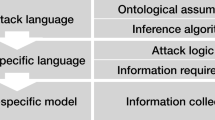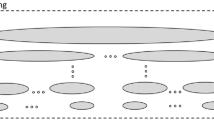Abstract
Business process modelling focuses on the modelling of functional behaviour. In this article, we propose an extension for the business process modelling notation to express non-functional authorisations requirements in a process model to enable the collaboration between security experts and business analysts. To capture multi-level, role-based and Separation of Duty authorisation requirements, new model element attributes and authorisation artefacts are introduced. To enhance the usability of this approach, simple visual decorators are specified to ease the communication of requirements between various stakeholders. To provide an early validation of these authorisation requirements during the definition of a process model, formal semantics are applied to the process model and model-checking techniques are used to provide feedback. As a pragmatic proof-of-concepts, a first prototype implementation is briefly discussed.











Similar content being viewed by others
References
Pavlovski CJ, Zou J (2008) Non-functional requirements in business process modeling. In: APCCM. pp 103–112
Russell D, Gangemi GT Sr (1991) Computer security basics. O’Reilly & Associates, Inc., Sebastopol
Hu VC, Ferraiolo DF, Kuhn DR (2006) Assessment of access control systems
Schneider G, Winters JP (2001) Applying use cases (2nd ed): a practical guide. Addison-Wesley Longman Publishing Co., Inc., Boston
Jacobson I (1995) The use-case construct in object-oriented software engineering. pp 309–336
Anjard RP (1996) Process mapping: one of three, new, special quality tools for management, quality and all other professionals. Microelectron Reliab 36(2):223–225
Dumas M, Arthur HM (2001) Uml activity diagrams as a workflow specification language. Lect Notes Comput Sci 2185:76–90
Object Management Group (2006) Business process modeling notation specification. http://www.bpmn.org
Wolter C, Schaad A, Meinel C (2008) Task-based entailment constraints for basic workflow patterns. In: SACMAT ‘08: proceedings of the 13th ACM symposium on access control models and technologies. New York, ACM, pp 51–60
Yu ESK (1997) Towards modeling and reasoning support for early-phase requirements engineering. In: RE ‘97: proceedings of the 3rd IEEE international symposium on requirements engineering (RE’97). IEEE Computer Society, Washington, DC, p 226
Bell DE (2005) Looking back at the Bell-La Padula model. In: ACSAC ‘05: proceedings of the 21st annual computer security applications conference. IEEE Computer Society, Washington, DC, pp 337–351
Clark DD, Wilson DR (1987) A comparison of commercial and military computer security policies. Secur Priv 00:184
Ferraiolo DF, Sandhu R, Gavrila S, Kuhn DR, Chandramouli R (2001) Proposed nist standard for role-based access control. ACM Trans Inf Syst Secur 4(3):224–274
Sejong OH, Park S (2003) Task-role-based access control model. Inf Syst 28(6):533–562
Di Renzo B, Hillairet M, Picard M, Rifaut A, Bernard C, Hagen D, Maar P, Reinard D (2007) Operational risk management in financial institutions: process assessment in concordance with basel ii. Softw Process 12(4):321–330
Chen KL, Shing M-L, Lee H, Shing C-C (2007) Modeling in confidentiality and integrity for a supply chain network. Commun IIMA 7(1):41–48
Schaad A, Lotz V, Sohr K (2006) A model-checking approach to analysing organisational controls in a loan origination process. In: SACMAT ‘06: ACM symposium on Access control models and technologies. ACM, New York, pp 139–149
Jaeger T, Sailer R, Zhang X (2004) Resolving constraint conflicts. In SACMAT ‘04: proceedings of the ninth ACM symposium on access control models and technologies. ACM, New York, pp 105–114
Gami N, Mikolajczak B (2007) Integration of multilevel security features into loosely coupled inter-organizational workflows. In: ITNG ‘07: proceedings of the international conference on information technology. IEEE Computer Society, Washington, DC, pp 653–657
Wang L, Wijesekera D, Jajodia S (2004) A logic-based framework for attribute based access control. In: FMSE ‘04: proceedings of the 2004 ACM workshop on formal methods in security engineering. ACM, New York, pp 45–55
Atluri V, Chun SA, Mazzoleni P (2001) A Chinese wall security model for decentralized workflow systems. In: CCS ‘01: proceedings of the 8th ACM conference on computer and communications security. ACM, New York, pp 48–57
Botha RA, Eloff JHP (2001) Separation of duties for access control enforcement in workflow environments. IBM Syst J 40(3):666–682
Lu R, Sadiq S (2007) A survey of comparative business process modeling approaches. Springer, Berlin, pp 82–94
Wohed P, van der Aalst WMP, Dumas M, ter Hofstede AHM, Russell N (2006) On the suitability of BPMN for business process modelling. In: Proceedings of the 4th international conference on business process management (BPM)
Jablonski S, Volz B, Dornstauder S (2008) A meta modeling framework for domain specific process management. In: COMPSAC. pp 1011–1016
Wolter C, Miseldine P, Meinel C (2009) Verification of business process entailment constraints using SPIN. In: To appear in international symposium on engineering secure software and systems
Zhang Z-L, Hong F, Xiao H-J (2006) Verification of strict integrity policy via petri nets. In: ICSNC ‘06: proceedings of the international conference on systems and networks communication. IEEE Computer Society, Washington, DC, pp 23
Ben-Ari Mordechai (2008) Principles of the spin model checker. Springer, Berlin
Goldblatt Robert (1987) Logics of time and computation. Center for the Study of Language and Information, Stanford
Tatsubori M, Imamura T, Nakamura Y (2004) Best-practice patterns and tool support for configuring secure web services messaging. In: ICWS ‘04: proceedings of the IEEE international conference on web services. IEEE Computer Society, Washington, DC, p 244
Sadiq SW, Governatori G, Namiri K (2007) Modelling control objectives for business process compliance. In: BPM. pp 149–164
Mylopoulos J, Chung L, Nixon B (1992) Representing and using nonfunctional requirements: a process-oriented approach. IEEE Trans Softw Eng 18(6):483–497
Giorgini P, Massacci F, Zannone N (2005) Security and trust requirements engineering. Lecture Notes in Computer Science. Springer, Berlin, pp 237–272
Hepp M, Roman D (2007) An ontology framework for semantic business process management. In: Wirtschaftsinformatik (1). pp 423–440
Nagaratnam N, Nadalin AJ, Hondo M, McIntosh M, Austel P (2005) Business-driven application security: from modeling to managing secure applications. IBM Syst J 44(4):847–868
Rodrguez A, Fernández-Medina E, Piattini M (2007) A bpmn extension for the modeling of security requirements in business processes. IEICE Trans 90-D(4):745–752
Mossakowski T, Drouineaud M, Sohr K (2003) A temporal-logic extension of role-based access control covering dynamic separation of duties. 00:83
Giblin C, Liu AY, Müller S, Pfitzmann B, Zhou X (2005) Regulations expressed as logical models (realm). Technical Report RZ 3616, IBM Research, Zurich, 07
Gannod GC, Gupta S (2001) An automated tool for analyzing petri nets using SPIN. ASE 0:404
Ouyang C, Verbeek E, van der Aalst WMP, Breutel S, Dumas M, ter Hofstede AHM (2007) Formal semantics and analysis of control flow in ws-bpel. Sci Comput Program 67(2–3):162–198
Fisteus JA, Fernández LS, Kloos CD (2005) Applying model checking to BPEL4WS business collaborations. In: SAC ‘05: proceedings of the 2005 ACM symposium on applied computing. ACM, New York, pp 826–830
zur Muehlen M, DT-Y Ho (2005) Risk management in the bpm lifecycle. In: Business process management workshops. pp 454–466
Wolter C, Schaad A, Meinel C (2007) Deriving XACML policies from business process models. In: WISE workshops. pp 142–153
Author information
Authors and Affiliations
Corresponding author
Rights and permissions
About this article
Cite this article
Wolter, C., Meinel, C. An approach to capture authorisation requirements in business processes. Requirements Eng 15, 359–373 (2010). https://doi.org/10.1007/s00766-010-0103-y
Received:
Accepted:
Published:
Issue Date:
DOI: https://doi.org/10.1007/s00766-010-0103-y




